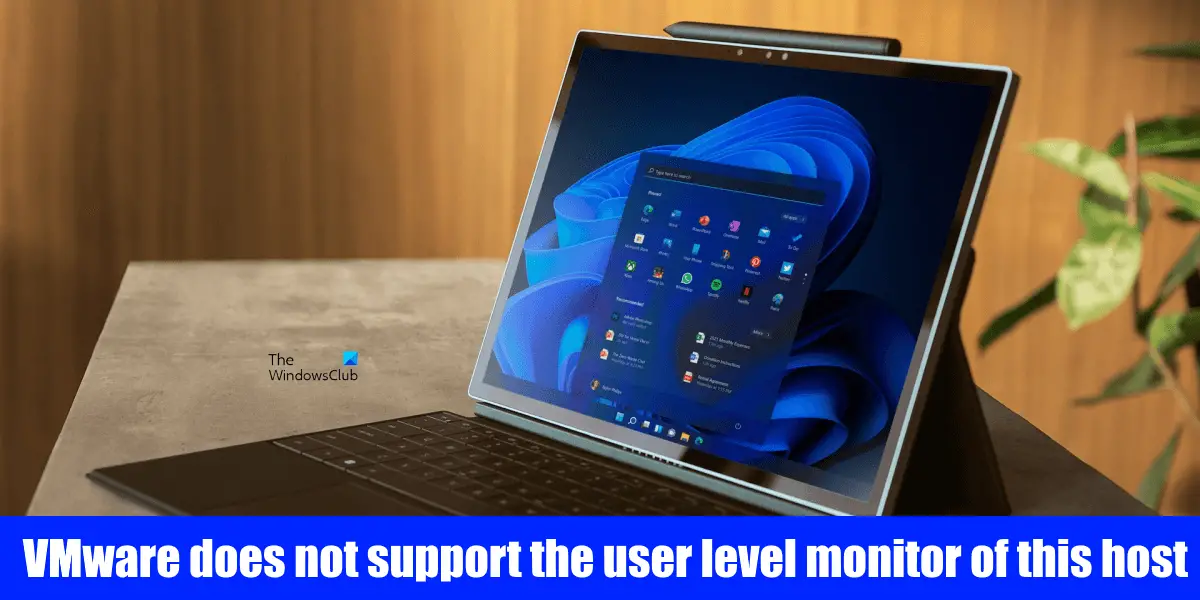VMware does not support the user level monitor of this host
If you are running VMware Workstation Pro on a Hyper-V-enabled Windows host, you may see the following error messages in addition to the “VMware does not support the user level monitor of this host” error message. In all the above cases, the VMware Workstation Pro does not start. The following solutions may help you resolve the issue; This host does not support “Intel EPT” hardware assisted MMU virtualization. This host appears to be running in a virtual machine with VHV disabled. Ensure that VHV is enabled in the virtual machine configuration file. VMware Workstation and Device/Credential Guard are not compatible. Let’s see all these fixes in detail.
1] Disable Hyper-V
As described above in this article, VMware Workstation Pro is not compatible with a Hyper-V-enabled Windows host. Therefore, if you have enabled Hyper-V on your Windows host machine, you will not be able to run VMware Workstation Pro on it. To fix this issue, you have to turn off Hyper-V in Windows Optional Features. The following steps will help you with that:
Check if the issue persists. If yes, try the next fix.
2] Stop all Hyper-V-related services
If VMware still refuses to start and shows you the same error message, there might be some Hyper-V-related services running on your system. Check this in the Windows Services Manager and stop the running Hyper-V services. Follow the steps written below:
The services set to Automatic start automatically on system startup. If the startup type of any Hyper-V service is set to Automatic, change it to Manual so that the service could not start by itself when you start your system. For this, right-click on the Hyper-V service, the status of which is Automatic and select Properties. Under the General tab, select Manual in the Startup type drop-down. Click Apply and then Click OK. After performing the above steps, restart your computer.
3] Disable Virtualization-based Security (VBS)
One possible cause of the problem is VBS technology. If Virtualization-based Security is enabled on your Windows host machine, you will not be able to run VMware Workstation Pro. To check if VBS is enabled on your system or not, follow the steps mentioned below:
If the VBS technology is running, you have to disable it. To do this go through the following instructions:
Read: Failed to lock the file, Module Disk power on failed on VMWare. If you have the Home edition, you do not have the Local Group Policy Editor. Hence, you can disable Virtualization-based Security (VBS) via the Registry Editor. Windows Registry is the hierarchical database of Windows OS. Any mistake while modifying the Registry can cause serious errors in your system. Therefore, before you begin, we recommend you create a System Restore Point and back up your Registry. Open the Run command box and type regedit. Click OK and click Yes in the UAC prompt. This action will open the Registry Editor. Copy the following path, paste it into the address bar of your Registry Editor, and hit Enter.
Make sure that the DeviceGuard subkey is selected on the left side. Check if the EnableVirtualizationBasedSecurity Value is available on the right side. If not, create it manually by following the steps written below: Right-click on the EnableVirtualizationBasedSecurity Value and select Modify. Its Value Data should show 0. If not, enter 0 in its Value Data and click OK. Now, copy the following path, paste it into the address bar of the Registry Editor, and press Enter.
Make sure that the Lsa subkey is selected on the left side. Now, check if the LsaCfgFlags Value exists on the right side. If not, create a DWORD (32-bit) Value manually by following the steps explained above and rename this Value as LsaCfgFlags. The Value Data of LsaCfgFlags should show 0. Right-click on it and select Modify to check what its Value Data shows. If 0 is not there, change its Value Data to 0 and click OK. Close the Registry Editor and restart your computer. This should work. Read: How to add TPM to VMware Player Virtual Machine in Windows 11.
Does VMware support Nested Virtualization?
Nested Virtualization is the process of running a Virtual Machine inside another Virtual Machine. The Outer Guest is the Virtual Machine that runs on physical hardware and the Inner Guest is the Virtual Machine that runs inside another Virtual Machine. Similarly, the Host Hypervisor is the hypervisor that runs on physical hardware and the Guest Hypervisor is the hypervisor that runs inside a Virtual Machine. The Type 1 Hypervisors are not supported as the Guest Operating Systems under any VMware product. ESXi is also not supported as a Guest Operating System under the production environments. However, if you want to run ESXi or ESX as nested virtualization, you need to obtain additional licenses for the nested ESXi/ESX. VMware products require hardware-assisted virtualization for 64-bit guests on Intel and AMD hardware. This means you can enable Nested Virtualization only if your CPU supports hardware-assisted virtualization. The hardware-assisted virtualization is called VT-x for Intel and AMD-V for AMD. You will see these options in your BIOS if your processor supports these technologies. Enter into your BIOS and look for the Intel Virtualization Technology option if you have an Intel CPU and AMD-V or SVM Mode if you have an AMD CPU. If you see these options in your BIOS, enable them.
How do I enable Nested Virtualization in VMware VM?
You can enable Nested Virtualization in your VMware VM by enabling the Virtualize Intel VT-x/EPT or AMD-V/RVI option in your Virtual Machine settings. But for this, your CPU should support hardware-assisted virtualization. You can enable the hardware-assisted virtualization on your system by entering into BIOS. We have already talked about how to check if your CPU supports hardware-assisted virtualization. I hope this helps. Read next: VMware Bridged network not working or detecting in Windows.
